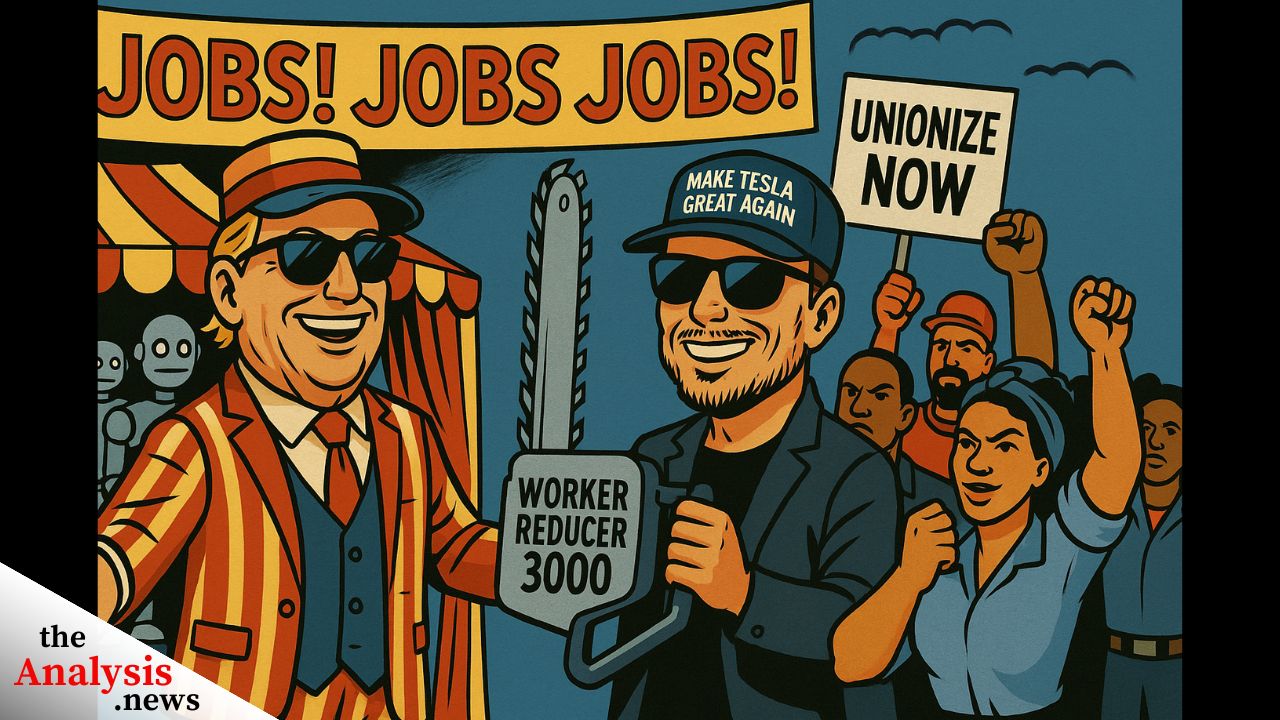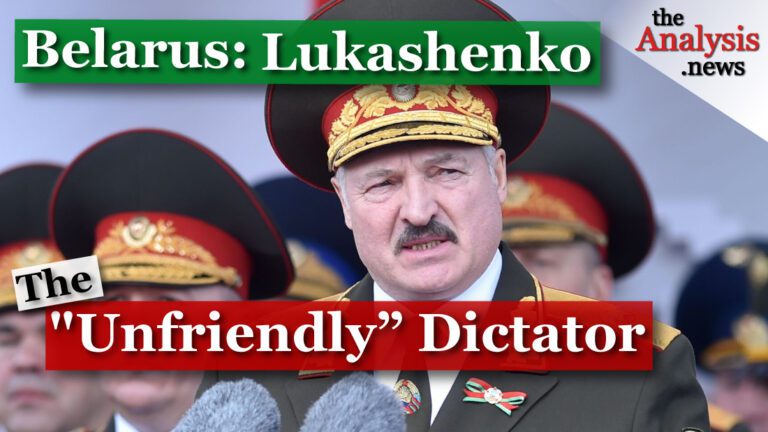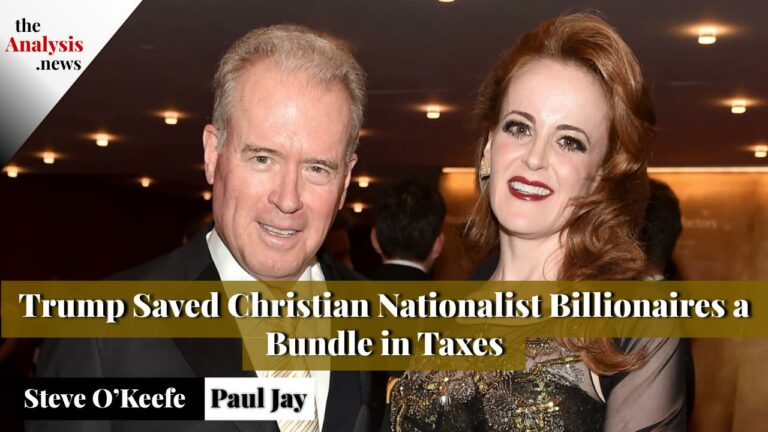Trump sells his tariff agenda as a jobs boom for American workers — but it’s a smokescreen for a global attack on labor. At home, new factories are routed to anti-union states, while Trump’s appointees quietly dismantle the NLRB to block worker organizing. Abroad, tariffs target export economies like China, Vietnam, and Bangladesh, fueling layoffs and driving down wages to benefit U.S. corporate margins. It’s a calculated campaign to suppress labor power worldwide. But the chaos it’s unleashed — from domestic legal battles to global economic disruption — suggests the plan may be backfiring. Even some of Trump’s allies are starting to question whether the madness is strategic… or just madness.
Part One – Trump Tariffs: The Madman Theory Applied to Economics (and what we should do about it)
Part Three – The Global Axis of the Far Right
Part Four – Cracks in the Trump Coalition: Civil War Among the Elites
Part Five – Building a Real Alternative: Get Organized
Podcast: Play in new window | Download | Embed
Subscribe Apple Podcasts | Spotify | Android | iHeartRadio | Blubrry | TuneIn | Deezer | RSS
[simpay id=”15123″]
Never miss another story
Subscribe to theAnalysis.news – Newsletter

Trump’s brand requires him to brag about “bringing jobs back” through tariffs and reshoring. But the real strategy is carefully designed to prevent those new jobs from empowering workers. Far from being pro-worker, his administration is actively preparing to weaken existing unions and block new organizing.
To the extent that tariffs do promote new manufacturing in the U.S., the strategy is to steer investment into mostly anti-union Southern and Midwestern states. Recent developments confirm the trend: Hyundai is building its largest U.S. facility in Georgia — a $12.6 billion project creating 8,500 jobs, plus $2.7 billion in new supplier factories. Toyota is developing a major battery plant in North Carolina, expected to support 800,000 vehicles annually and employ 5,000 workers. In Texas, Apple and Nvidia are launching AI hardware and supercomputer manufacturing hubs. All of these are located in right-to-work states with weak labor protections and low union density — part of a broader pattern of channeling industrial growth into regions where organizing is discouraged and collective bargaining power is minimal.
The National Labor Relations Board (NLRB) — the federal agency that enforces workers’ rights to organize — is the only body that can legally certify the results of a private-sector union election. Without certification, employers have no legal obligation to bargain. But Trump’s agenda for the NLRB is clear: dismantle Biden-era labor protections and obstruct union organizing. He began by firing pro-union board member Gwynne Wilcox, a move now under Supreme Court review. Her removal left the five-member Board with only two sitting members — below the quorum of three required to issue decisions. Trump has made no move to fill the remaining vacancies. At the same time, he appointed Marvin Kaplan, a longtime ally of management, as NLRB Chair, and installed William Cowen as Acting General Counsel — both known for advancing pro-business interpretations of labor law. The result is strategic paralysis: the Board cannot certify unions, rule on appeals, or enforce key worker protections.
Employers can now hold union elections — then stall certification indefinitely by appealing to a Board that cannot rule. Trump’s refusal to restore a quorum appears calculated: a deliberate effort to sideline the NLRB as a check on corporate power while quietly restructuring its enforcement arm from within.
The objective is clear: weaken existing unions and make it far more difficult to organize unorganized workers.
Trump’s plan also includes weaponizing nationalism to frame unions and strikes as “unpatriotic.” A notable example is the executive order he signed on March 27, 2025, which aimed to strip collective bargaining rights from over one million federal workers, citing national security concerns. Labor leaders condemned the move as an attempt to cast union activity as a threat to the nation. Everett Kelley, President of the American Federation of Government Employees (AFGE), called the order “a disgraceful and retaliatory attack on the rights of hundreds of thousands of patriotic American civil servants — nearly one-third of whom are veterans — simply because they are members of a union that stands up to his harmful policies.”
So, what is Trump’s patriotism, really? Loyalty to the American people — or, as Dr. Johnson warned, “the last refuge of a scoundrel” — a cloak for self-interest?
Global Tariffs Are a Weapon Against Labor Worldwide
One of the sharpest — and least discussed — aspects of Trump’s tariffs is their global impact on labor.
By hitting China, Bangladesh, Vietnam, Cambodia, and other export-driven economies with punishing tariffs, Trump’s strategy disrupts factories and supply chains heavily reliant on labor-intensive sectors such as textiles, electronics, and other forms of industrial manufacturing.
It has forced mass layoffs, wage freezes, and wage cuts in countries where millions of workers had begun winning modest economic gains. It weakens bargaining power across the Global South, fueling a global “race to the bottom” for wages and working conditions.
Even within China — where industrial wages had been rising steadily — the trade war threatens to stall or reverse that progress, increasing social strain and undermining one of China’s key internal strengths: its growing middle class.
In this sense, the tariffs are not about protecting American jobs — they are part of a deliberate global war on labor, designed to push labor costs down worldwide, increase corporate profit margins, and reassert U.S. economic dominance by weakening the industrial bases of emerging economies.
As economist Jayati Ghosh pointed out, these tariffs amount to “wanton cruelty” against some of the most vulnerable populations on Earth — and risk triggering political and social upheaval in already fragile states.
This global attack on labor is not a by-product — it’s a strategy. By driving down wages internationally, Trump’s allies hope to create a world where U.S.-based firms — protected by tariffs and subsidized through militarized public spending — can dominate high-value industries without facing rising labor costs at home or abroad.
That’s the plan. But it’s already unleashing global disruption — and is unlikely to deliver lasting economic power for the United States. Even some of Trump’s backers are beginning to wonder whether the lunacy is more than just a tactic.
And when it fails, the response won’t be retreat — it will be escalation: deeper repression, harsher nationalism, and more authoritarian control. That’s why workers must become consciously organized — not just to defend their rights, but to confront the system driving the crisis.
This is the end of part two. In the next segment, I’ll be looking tariffs and the Global Axis of the Far Right.
Again, please be patient, the final part will be about people who are organizing to resist and how we can take advantage of the chaos, to build a better world.





